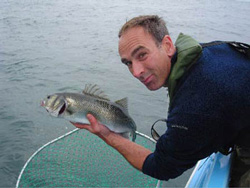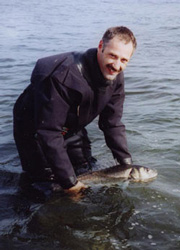Introducing the BASS restoration project
Ever since it was first formed in 1973, BASS has been campaigning for the conservation and improvement of the recreational bass fishery, with some success. A few dedicated members of BASS and others, were heavily involved in the efforts to introduce a minimum landing size (MLS) for bass and its gradual increase to the current 36 cms. Again, in the 1990s, BASS members played their part in the establishment of bass nursery areas.
[photo – thinking of the future, as Mathew Spence prepares to return another bass]
However with the continuing collapse of many fish stocks through commercial overfishing in the late 1990s and the worrying development of the winter offshore bass fishery it became evident that a greater emphasis must be placed on conservation. So, in 1998, BASS started this project, to campaign for more and bigger bass (Dicentrarchus labrax) to be available for recreational anglers.
In recent years, as a result of evidence produced from an extensive bass tagging programme BASS has been involved in, it has become evident that the lions share of fishing mortality of bass stocks, takes place within the inshore fishery. It is critical therefore that the UK government institutes proper management controls for the inshore bass fishery (See the bass management plan).
The restoration project has so far been successful in helping to achieve:-
UK government imposed quotas for bass landings during the winter offshore bass fishery (1999)
The Department for Environment, Food & Rural Affairs (Defra) recognised the needs of the sea angling sector in their formal response to the common fisheries policy Review (2001)
Anglers have been acknowledged as, ‘Stakeholders’, in the common fisheries policy (CFP) and included in the regional advisory council participation proposals (2002)
In 2003 Defra committing to a socio-economic study of recreational sea angling – Drew study, published in july 2004
Promoting, together with the Government Office, South West and the National Federation of Sea Anglers ( NFSA), a workshop to discuss the sustainable use of natural resources and the development of alternative fisheries management policies, to benefit the peoples and the economy of the South West. (2003)
Preliminary consultations (2003) with the Cabinet Office, Strategic Unit, prior to the Cabinet Office, Strategic Unit, UK fisheries consultation exercise ( report published 25 march 2004).
Preparation of the ‘Bass Management Plan’, produced at the request of Defra, in order to provide crucial evidence required to support recommendations made by the Cabinet Office Strategy Unit report, ‘Net Benefits’ into the future of the UK fisheries
Invited , together with the Sea Anglers’ Conservation Network (SACN) and the NFSA Conservation Group, to submit evidence to the Environment, Food and Rural Affairs government select committee on the future of UK fishing policy.
Regular consultations with Defra concerning the future management of the inshore bass fishery, including extensive discussions on the implementation of the ‘Bass Management Plan’
The work of the BASS restoration project continues to gain momentum, it is making a difference.
Are you an angler who wants to catch more and bigger bass?
Are you in the fishing tackle trade or an angling-related business?
Are you in a business involved with coastal tourism?
Then you should read on…….
For the past decade or more the angling press has been full of headlines like these:-
“Fish stocks collapse” – “Match won with 3 oz whiting” – “By catch scandal wastes resources” – “Dolphins die in nets” – “Politicians ignore scientific advice”
The pressures on commercially-fished stocks in our own waters and all around the globe have increased year on year, and we anglers have been able to do little more than read about it.
While the fishing industry has geared itself up with ever more efficient equipment, larger boats and nets, we anglers have suffered a slow and gradual decline in the quality of our sport. The numbers of fish that we catch and the sizes of those fish has dropped to an all-time low. Sea angling, one of the nation’s most popular pastimes, is in danger of becoming an activity of the past purely because of the lack of the most essential ingredient in angling – FISH.
Well, the time to just sit back and read about the disastrous mis-management of our fish stocks, a commonly owned resource, is over.
The Bass Anglers’ Sportfishing Society has embarked upon a project to raise awareness of the huge social and economic benefits of angling, and in particular sportfishing. The capture of fish for sport not profit is at the heart of our message.
A vision for the long term management of a shared resource
Recruitment during the 1990s and early 2000s has been generally excellent due to mild winters combined with 37 bass nursery areas in those estuaries shown to be important for immature bass in the UK. If the relatively abundant young adult bass can be protected from the severe fishing mortality incurred through inshore gill-netting, within a further three years these bass would be approaching 2kg. For example, the excellent 2002 year class, if allowed to survive, would by the year 2012 typically be approaching 2kg.
Our vision on how this can be achieved is contained in the ‘Bass Management Plan’ (BMP), a document prepared by BASS and presented to Defra in november 2004.
This document was produced at the request of Defra, following the publication in march 2004 of the Prime Minister’s Strategy Unit report, ‘Net benefits, A sustainable and profitable future for UK fisheries’. The document details proposals for the future management of UK bass stocks, concentrating on the needs of the UK recreational sea angling sector.
Briefly, the Bass Management Plan (BMP) makes 7 recommendations:-
1. Bass commercial licences – for the retention of bass.
2. Bass carcass tags – to cap effort, increase traceability and improve enforcement.
3. Bass bag limits – to limit the retention of bass by unlicensed fishermen and anglers and to aid detection and enforcement of illegal fishing.
4. Closed season – to protect spawning bass when they are vulnerable.
5. Increases in minimum landing size – to strengthen the brood stock.
6. Nursery area additional measures and enforcement – to protect juveniles.
7. Near-Shore netting restrictions – to protect our fragile coastal zones.
The BMP not only provides the evidence to support management for recreational use, but also provides details of the legal mechanisms available, in order to achieve a revitalized bass fishery.
A full copy of the BMP can be read or downloaded from this web site.
Why you should support us
The combination of good spawning successes since the 1990s, the introduction of bass nursery areas and the northward extension of bass stocks, provides the opportunity to develop a very significant, sustainable marine sport fishery.
If you are an angler: this means improved sport as more and bigger bass will be available.
If you work in an angling-related business: this means more business and profits for you.
If you work in tourism: this means more anglers and their families’ spending money in UK coastal resorts.
[photo – John Morgan returns a bass, so others can enjoy]
Bass belong to us all, and to the future.
Your help will make a difference, please support the BASS restoration project. Thank you.
How you can help.
A significant increase in political lobbying by the recreational sea angling sector is required to bring this project to fruition. Real progress has already been made, however much more can and needs to be done.
This work is currently being carried out by committed anglers, on a voluntary basis. The project is funded entirely by donations, mostly from BASS members. We are very very grateful for these, but we always need more.
In other parts of the world where sea anglers have achieved a level of recognition that in Europe we can only dream about, the key was sufficient funding for full time professional representation. Support from grass root sea anglers could easily provide the sort of money required to employ experts and this remains one of our goals. In the meantime there are several ways you can help the project to succeed.
Firstly, by supporting us financially. We need a steady stream of funds to continue the work.
Secondly, you can join BASS
Finally, if you have time, and or skills that could help in the task ahead, we are keen to hear from you.
Making donations to the project
Cheques should be made payable to BASS restoration project and sent to:-
Clive Hodges
BASS Treasurer
15 Northfield Way,
Patcham, Brighton,
Sussex
BN1 8EH
A bank standing order mandate will allow you to make regular monthly, quarterly or annual amounts and will assist in planning our work. (If you do not have Acrobat Reader, a free copy can be downloaded from the Adobe web site.
Or you can Donate using the ‘button’ on the BASS Website Homepage
Full details of how the money has been and will be used, are given at the AGM. Any member who would like to know more about how their money is being spent, can contact the BASS Treasurer, who will be happy to provide details. Email BASS Treasurer: clive_hodges [at] hotmail [dot] com
Restoration project newsletter
For those of you who wish to be kept informed about the work of the restoration project team, copies of the restoration project newsletters can be downloaded from this website.

